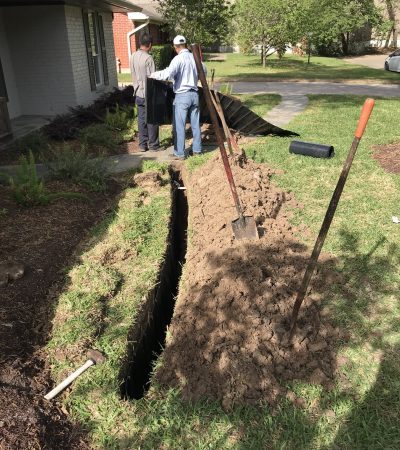Installing Root Barriers Without Harming Trees
Texas tree roots can be a big problem
Tree roots in Texas grow in whatever direction they can find the right amount of water and nutrients. And whether you are in Houston, Austin, or anywhere else, you need to understand the effects tree roots can have on buildings and foundations. Sometimes the tree root direction is harmless, and sometimes it is right into your home foundation or under a perfectly flat sidewalk. There is nothing worse than seeing stress cracks in your beautiful Texas home from a tree that was planted too close without the proper precautions. Chances are you have seen a tree with roots growing wildly around downtown Houston, disrupting sidewalks or other things around them. When tree roots spread where you don’t want them, they can cause damage to plumbing, foundations, concrete, and anything else that happens to be in their path. That’s where tree root barriers come in.What are root barriers?
There are many different types of root barriers commonly used in Houston and around the lone star state, but they all have the same goal in mind: to stop tree roots from disrupting things around them without actually harming the tree. Most root barriers are made from durable plastic or fabric sheets that are made to connect with one another. Many have guides that encourage roots to grow downward rather than out or up. You could think of a root barrier as if they are walls that guide roots in a different direction.Do root barriers work?
Root barriers can work tremendously well when installed properly. While they generally work best with freshly planted trees, they can still be done with trees that have been in place for a few years. Root barriers should be seen more as a preventative measure rather than the solution to an already found problem. So, if you are already noticing problems, it is likely too late for a root barrier to help. Texas trees can grow quickly, so do not delay if you think you may have an issue that could cause more problems down the line.
How do root barriers not harm the trees?
Root barriers can be the key to how we don’t harm trees, while still protecting our driveways, foundations, and sidewalks. The tree root barrier is made to redirect the tree roots from growing into something they shouldn’t, not to harm or kill the tree. When done correctly, at a proper time and place, root barriers will not harm trees in any way. Incorrectly installed root barriers will not allow the tree to develop the root system it needs to be supported and grow into a large and healthy tree.Tree root barrier installation
Root barrier installation can be a bit of a tedious task, and is best done by a professional. If you are curious about the process however and want to know what all the professional will be doing in your yard before hiring one, take a look at the steps of a root barrier installation below.- Measure how far away to dig the trench. For trees and shrubs, a professional will plan on digging the trench about three times the trunk’s diameter away from the plant. You may see them lay down a tarp before digging, it is easier to place the dirt on this tarp to be used to fill in the trench again later.
- Start digging. These professionals will dig a narrow trench with a trench digger or shovel about 18 inches for plants and about 30 inches for trees.
- Slide the panels in the trench. Professionals can then align the barrier with the side of the trench; some barriers are interlocking and some are not. Panels will be installed according to the type used for that trench.
- Fill in the trench. Your professionals may pour water in the trench after filling to pack down the soil and then continue adding soil until the ground is level.

Trees that won’t damage your landscape
If you are just looking for nice big trees to plant in Texas that won’t harm your landscape later on, you’re in luck. These local trees are a great choice in Houston, Austin, San Antonio, or anywhere else in Texas:- Oaks – Oaks are fast growing and rated low for landscape damage. Some specific examples are the Southern Red Oak and the Chestnut Oak. These trees can grow 65-80 feet high very quickly. They grow best in the abundant sunlight and acidic soil of Texas.
- Maples – Some great maple examples are the Southern Sugar Maple and the Amur Maple. While these trees won’t generally grow over 30 feet high, they have a very large canopy and offer perfect shade on those hot summer days. Both of these trees like well-drained soil and full sun to partial shade.
- Pagodas – The “Princeton Upright” Pagoda grows up to 50 feet tall and the Weeping “Pendula” Pagoda grows to about 25 feet. They both offer a lot of shade and like lots of sun with acidic to alkaline soil.
- Horsechestnuts and Buckeyes – Another two great choices are the Indian Horsechestnut and the Yellow Buckeye. The Yellow Buckeye grows up to 80 feet high, while the Indian Horsechestnut can grow up to 50 feet. Both trees prefer full sun and a variety of well-drained soil.
Before planting any type of trees, be sure to check your USDA zone to be sure you are safe to plant. These trees are more common in Texas, but will depend on what part of the state you live in.
If you are looking for professional advice or services in the Houston, Austin, and San Antonio, Texas regions, Aftermath Repair would love to help. Our expert team knows exactly what to do with those bothersome tree roots, so feel free to contact us today for a free analysis.

